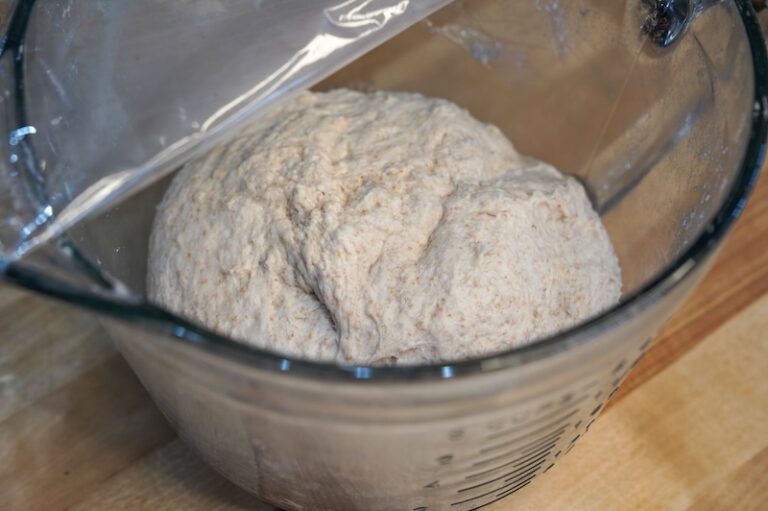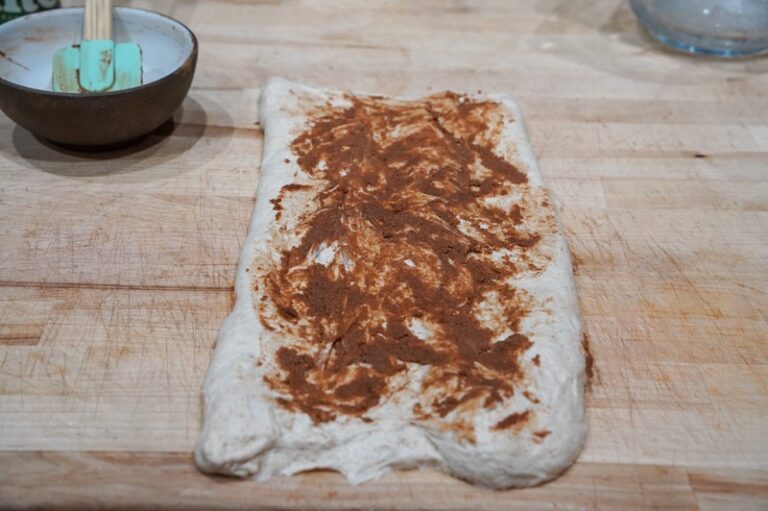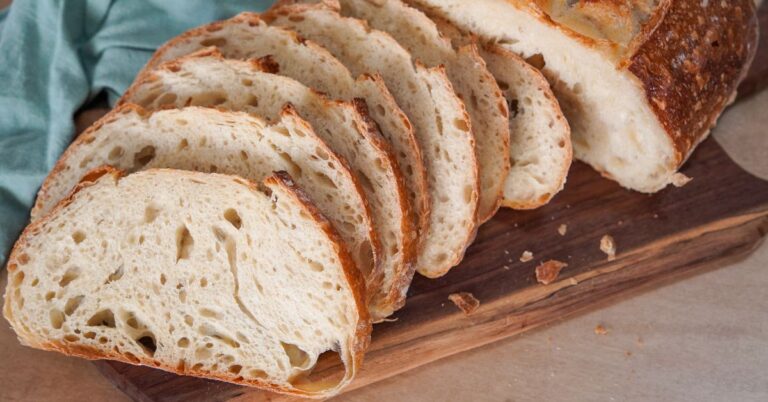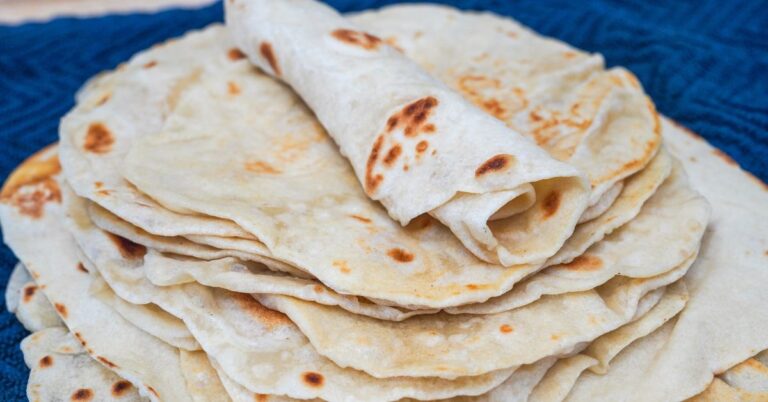Cinnamon Swirl Sourdough Bread Recipe: No Stress, No Leaks
Cinnamon Swirl Sourdough Bread Recipe: No Stress, No Leaks

Cutting into a loaf of cinnamon swirl sourdough bread has the same energy as a gender reveal: it’s beyond exciting to see a perfect spiral of brown sugar and cinnamon peeking back at you.
But getting to that moment is NOT easy. After six attempts (yes, six), I finally cracked the code for a zero-stress, zero-leakage cinnamon sugar sourdough loaf that also delivers a dreamy swirl.

If you follow me on my Instagram stories, you know how much effort went into this experiment.
Catch a recap of this entire journey here:
I’m as humble as they come, but this recipe truly checks all the boxes:
- No stress during the shaping
- A perfect swirl in every loaf
- No leaking sugar that’s messy and ends up burning in the oven
- No separation of the layers inside
I gave up on cinnamon sugar sourdough bread for months because I loathed the entire process. Not anymore!
If you’ve been dreaming of a cinnamon swirl sourdough that feels artisan-level but approachable, this recipe is for you.
If you prefer a soft bread, like the Pepperidge Farms cinnamon swirl bread, try this recipe: Cinnamon Raisin Swirl Sourdough Bread Recipe (Pepperidge Farms Copycat)
YouTube Step-by-Step Tutorial
If you’re a visual person, or just want to pick up on those details you can only see on film, here is a YouTube tutorial.
It has timestamps in the description so you can jump ahead to whichever step you need.
Baker’s Timeline

| Day 1 | |
| 9:00 PM | Feed your starter a 1:5:5 feeding ratio. |
| Day 2 | |
| 8:00 AM | Mix the dough, cover, and let sit on the counter for 30 mins. |
| 8:30 AM | Stretch and fold #1. |
| 9:00 AM | Stretch and fold #2. |
| 9:30 AM | Stretch and fold/coil fold #3. |
| 10:00 AM | Stretch and fold/coil fold #4; let the dough bulk ferment. Timing varies. |
| 4:00 PM | Laminate the dough and add cinnamon sugar mixture. Flip into lined banneton and refrigerate overnight. |
| Day 3 | |
| Anytime | Score & Bake at 450°F for 30 min covered, 10-15 mins uncovered. |
Ingredients
For the Dough:
- Water: I use water straight from my faucet. I live in the country and have well water; I’ve never had any issues. However, I’ve seen others recommend using Spring water.
- Active Sourdough Starter: Bubbly and at its peak for baking. Related: Is My Sourdough Starter Ready to Bake With? How I Can Tell
- Sea Salt: I use sea salt – pink Himalayan at the moment, but I switch it up. Just try to avoid salt with anti-caking agents.
- Bread Flour: I use King Arthur’s unbleached bread flour (12.7% protein) for all my loaves.
- Whole Wheat Flour: I used Sunrise Flour Mills for this one. Adds a nutty flavor and speeds up fermentation, but if whole wheat is not your thing, you can use all bread flour.
For the Filling:
- Softened Butter: Set it out beforehand so your cinnamon sugar mixture is the right consistency.
- Cinnamon: The star of this recipe! Ceylon cinnamon seems to be everyone’s favorite. Saigon cinnamon packs a spicy punch.
- Brown Sugar: Cinnamon’s wingman; adds that irresistible sweetness. If you don’t have any on hand, you can mix white sugar with molasses to make your own.
- Bread Flour: A bit of bread flour in the cinnamon sugar mixture helps absorb some of the moisture so it’s not too runny. It also helps the filling stay in place when you roll it up which is one of the secrets to the perfect swirl! You can sub in all-purpose flour, no problem.
How to Make Cinnamon Swirl Sourdough Bread (Step by Step)
Step 1: Feed Your Starter
Getting your starter ready at the perfect time is all about the feeding ratio. If you want it ready by morning, feed it right before bed using a 1:5:5 ratio. This slows things down so it peaks in 10-12 hours.
Mix 15g starter + 75g water + 75g bread flour so you end up with about 45g extra to maintain your starter.
Alternatively, if you’re starting in the morning and want it ready by around noon, go with a 1:1:1 ratio, which speeds things up so it peaks in 4-6 hours. For that, mix 50g starter + 50g water + 50g bread flour.
Either way, you’ll know it’s ready when it’s bubbly, flat on top, and ideally, tripled in size.

Not sure if your starter has peaked? Check out: Is My Sourdough Starter Ready to Bake With? How I Can Tell
Step 2: Mix the Dough
When your starter has peaked, mix everything for the dough in a bowl: 325g water + 120g active sourdough starter + 10g sea salt + 400g bread flour + 100g whole wheat flour (or just 500g bread flour if you prefer—no other changes needed).
If you’d rather skip the whole wheat, you can use 500g of bread flour instead—no other changes needed. You could reduce the water by 10-20g if you want the same texture, but I say keep it simple!
Mix until fully combined. The dough may look shaggy and feel sticky at this stage—that’s normal! It may not be smooth or even yet, but as long as everything is mixed, you’re good to go. I kneaded by hand for 4-5 minutes.

Cover your bowl with plastic wrap, a shower cap, or a dish towel, and let it rest for 30 minutes—this kicks off bulk fermentation.
This is when you can set out 4 tablespoons of butter to soften for later.

Step 3: Stretch and Folds
After 30 minutes, start your first set of stretch and folds.
With the dough still in the bowl, grab one side, stretch it upward, and fold it over itself. Rotate the bowl and repeat this on all four sides. I typically do 8-10 stretches, or until the dough tightens up and resists me.


Do this every 30 minutes for 3-5 rounds, depending on how strong the dough feels.
If you’re not sure, it’s always safe to aim for 4 rounds.
For the last couple of rounds, you can switch it up and try a coil fold. Lift the dough from the center, let the edges drape down, and tuck them underneath as you set it back down. Coil folds are gentler on the dough and don’t pop as many bubbles, which start forming as the bulk fermentation goes on.
After all your folds, cover the dough and let it rest until it’s finished fermenting.
Step 4: Bulk Fermentation
Remember, the fermentation clock started as soon as you added your starter to the dough.
I’ve always followed charts in the past to know when to cut off bulk fermentation, but lately, I’ve been pushing those limits and learned that how the dough looks and feels matters more. Learning to read the dough has been a massive help for me.
You want to see a dough that’s airy, puffy, and slightly domed with tons of bubbles all around the sides of the bowl. It should jiggle like jello when you shake the bowl and feel soft and puffy when poked.
Don’t be afraid to push the limits a bit. Slightly overproofed dough tends to bake up better than underproofed dough, so when in doubt, just let it sit a little longer.
For me, this takes about 8 hours at a 70°F (21°C) temperature, but every kitchen is a little different, so just keep an eye on it. The dough will tell you when it’s ready.
Step 5: Spread Into a Rectangle
Now that bulk fermentation is done, it’s time to shape your dough for the cinnamon filling.
If you were making a regular sourdough loaf, this is when you’d pre-shape. But for a cinnamon swirl loaf, skipping pre-shaping makes it easier to stretch into a rectangle since there’s less tension on the dough.
Mist your counter with a little water to prevent sticking (optional, but helpful) and turn the dough out.
Stretch the dough into a 13×16 inch rectangle for the filling. You don’t necessarily need a measuring tape, but if you’re not sure how far to stretch, this is about the size my dough was during recipe testing.

If you see any thin areas or holes, just stretch some extra dough over it to patch them up to avoid any big holes in the crumb.
Step 6: Add the Filling
In a small bowl, mix 4 tbsp softened butter + 1 tbsp cinnamon + 5 tbsp brown sugar + 2 tbsp bread flour.

Tip: Your butter needs to be soft to get the right consistency. If you forgot to set it out, pop it in the microwave on the “soften” setting until the center is soft and the edges are slightly melted. If the mixture still feels too dry, add an extra tablespoon of butter or pop it in the microwave for 10 seconds or so.
With your dough rectangle in front of you (long side at the bottom), imagine it divided into three columns. Spread half the cinnamon sugar mixture evenly over the middle column (and maybe slightly more) using a silicone spatula.

Then, grab the left edge of the dough and fold it toward the middle. Repeat with the right edge so you have one long seam down the center. Pinch the top and bottom to seal in the filling so no cinnamon filling leaks out.


Spread the rest of the cinnamon sugar filling evenly over the top, leaving about an inch on each side. This will help create a clean seal so it doesn’t leak out.

Step 7: Roll It Up
Grab the bottom edge of your dough (a bench scraper helps if it’s sticking) and start rolling it up toward the top. Try to keep cinnamon sugar off the edges so the seam seals properly.

When you get to the end, gently pinch the seam to close it up. If you can see the swirls at the ends, push them to the inside with your fingers and pinch the ends shut. You want a good seal, but don’t squeeze too hard—you don’t want to tear the dough.
Step 8: Cold Retard
Pick up your dough log and plop it into the banneton, seam-side up.

A silicone batard-shaped banneton would be ideal if you’re worried about any cinnamon sugar leaking during the cold proof. But since I didn’t have one, I used my wood pulp banneton lined with a thin towel, and it worked out well.
You can flour the dish towel if you want, but you don’t have to. The dough peels off easily without it.
Try not to mess with the dough too much here. Just make sure the seams are sealed, and if there’s a spot that’s not, gently pinch it shut being careful not to mess up that swirl!
Cover it with the extra dish towel and put it in the fridge overnight. Anywhere from 8 hours to 4 days works, but overnight is best.
Step 6: Score & Bake
The next day (or at least 8 hours later), preheat your oven to 450°F (230°C) with your Dutch oven or bread dome inside to heat up.
Flip the dough onto a piece of parchment paper. I’d normally use a bread sling, but on cinnamon swirl loaves, I stick with parchment paper for easier cleanup in case any filling leaks out.

Even though I’m confident after baking this recipe successfully a few times, I’d still recommend using parchment paper if this is your first go. Better safe than sorry!

Score the top of your dough on a diagonal using a curved razor blade. The curve helps the blade glide through the dough at an angle, which helps it expand beautifully in the oven. You can also score straight down to prevent an ear from forming if you prefer.

If you want a more dramatic ear (the raised edge), you can go back over the score and lightly score just under the surface all the way down.

Bake your loaf for 30 minutes with the lid on.

Then remove the lid and bake for another 10-15 minutes uncovered until it’s golden brown. Keep an eye on it so it doesn’t burn. Every oven is a little different.

The bread is done when it reaches an internal temperature of 205-210°F (96-99°C).

Another cinnamon sourdough recipe you might like: Sourdough Cinnamon Crunch Bagels (Panera Copycat)
FAQs
Can you add icing to the top?
Definitely! My mom loves to drizzle hers with a little icing. Just mix together 2 tablespoons of softened butter, 2-3 tablespoons of softened cream cheese, about 3/4 cup of powdered sugar, and a splash of vanilla. If you like your icing thicker, you can add more powdered sugar. Spread it on top of each slice like you would butter.
My butter mixture wasn’t as spreadable as yours. What gives?
Some bakers have mentioned that their butter mixture turned out more crumbly than mine. The likely culprit? Butter consistency. I tend to forget to set mine out to soften, so I use the microwave’s soften function, which leaves it soft in the center with slightly melted edges. If your mixture is too dry, simply mix in another tablespoon of softened or melted butter to make it more spreadable.
How can I shape this into a boule instead of a batard?
I’ve perfected the swirl shaping for a batard, but I’m still refining it for a boule. For now, I suggest stretching the dough into a square rather than a rectangle—this creates shorter sides, making it easier to roll up and pinch the seams into a rounder shape. I’m still testing, but this should help achieve a more even boule!
Can’t you just put this in a loaf pan?
Absolutely! You can roll it up and bake it in a loaf pan for an easier approach. I just wanted to perfect this method for an artisan-style loaf.
Can I use my own sourdough bread recipe as the base?
Yes, if you have a favorite sourdough bread recipe, you can use that for the main dough.
Can the whole wheat flour be subbed out for bread flour?
Yes, you can use all bread flour in the main dough if you prefer. No other changes to the recipes are needed.
Can I add raisins?
You can add raisins during the lamination process to make a cinnamon raisin sourdough loaf. Soak 85g of raisins in vanilla extract (or water) for 30 minutes, then drain, saving the vanilla for later use in something like sourdough discard waffles. After spreading the cinnamon sugar mixture on the dough, sprinkle the soaked raisins on top, repeating this step each time you add the cinnamon mixture to ensure even distribution.
Other inclusion breads to try:
- Italian Herbs & Cheese Artisan Sourdough Bread Recipe
- Olive Parmesan Artisan Sourdough Bread Recipe
- Sun-dried Tomato and Goat Cheese Sourdough Bread Recipe

Cinnamon Swirl Sourdough Bread Recipe
Equipment
- Dutch oven ($15 off with code REBEKAH15)
- Oval banneton (5% off with code TSG5) | Size I'm Using: Oval – Spiral MD
Ingredients
Sourdough Starter
- 15 g sourdough starter (active or discard)
- 75 g water
- 75 g bread flour (unbleached, King Arthur)
Main Dough
- 325 g water
- 120 g of your active sourdough starter
- 10 g sea salt
- 400 g bread flour (unbleached, King Arthur)
- 100 g whole wheat flour (Sunrise Flour Mills)
Filling
- 4 tbsp softened butter
- 1 tbsp cinnamon
- 5 tbsp brown sugar
- 2 tbsp bread flour
Instructions
Feed Your Starter
- The night before making your dough, feed your starter a 1:5:5 feeding ratio by mixing 15 g sourdough starter, 75 g water, and 75 g bread flour. This gives you 45 extra grams, so you don’t have to scrape the jar clean (use the leftovers to maintain your starter). At this ratio, your starter should peak in 10-12 hours.Starting in the morning instead? Use a 1:1:1 ratio for a faster peak (4-6 hours). Combine 50 g starter, 50 g water, and 50 g bread flour.
Make the Dough
- In the morning, when your starter has peaked (see Recipe Notes for help), mix 325 g water, 120 g of your active sourdough starter, 10 g sea salt, 400 g bread flour, and 100 g whole wheat flour in a bowl. Mix until the ingredients are fully combined and the dough is shaggy. Cover the bowl with plastic wrap, a shower cap, or a cloth, and let it rest for 30 minutes. (This is the beginning of the bulk fermentation.)

- Set aside 4 tbsp of butter on the counter to soften for later.
- After 30 minutes, perform your first set of stretch and folds (or coil folds). Repeat this every 30 minutes for a total of 3-5 rounds, depending on how strong the dough feels. If you’re unsure, aim for 4 rounds to be safe. Once finished, cover the dough and let it rest until bulk fermentation is complete.

- Bulk fermentation is done when the dough is visibly larger (the exact percentage rise is not as important as the other visual signs), with bubbles all around the sides and underneath the surface. The dough should jiggle like jelly when you shake the bowl and feel light, airy, and puffy to the touch. It should be domed on the edges where the dough meets the bowl. Don’t worry about exact timing; trust these visual and tactile cues to guide you. Warmer dough ferments faster, colder dough takes longer, but slightly overproofed dough often makes better bread than underproofed. Don't be afraid to push the limits. For this recipe, my bulk fermentation took 8 hours at a 70°F (21°C) average temperature. Another test at 75°F (24°C) took just under 6 hours.
- When the bulk fermentation is done, lightly mist your work surface with water and dump out the dough. Gently flatten it into a rectangle, about 13" wide x 16" long.
Add the Filling, Shape, & Cold Retard
- In a small bowl, mix 4 tbsp softened butter, 1 tbsp cinnamon, 5 tbsp brown sugar, and 2 tbsp bread flour.

- Spread half the mixture evenly across the center of your dough rectangle. Visualize the rectangle divided into thirds—cover the middle third and slightly overlap into the sides for a slightly wider spread.

- Fold the dough’s sides to the center and pinch the seams closed.

- Spread the remaining mixture along the new center, leaving a gap around the edges for sealing.

- Roll the dough tightly into a log, pinching the edges to seal as you roll.

- Place seam-side up into a floured, towel-lined banneton. Cover and refrigerate overnight (8 hours up to 4 days; overnight is best).

Score & Bake
- The next day (or at least 8 hours later), preheat your oven to 450°F (230°C) with a Dutch oven or bread dome inside.
- Flip the dough onto parchment paper, score the top, and bake for 30 minutes covered and 10 minutes uncovered (watch closely to prevent burning).

- The bread is done when it reaches an internal temperature of 205-210°F (96-99°C).

Video

Notes
Conclusion
It took me quite a few tries (and almost happy tears when I finally nailed it), but I finally got that perfect cinnamon swirl!

Now, you can skip the trial and error and dive right into baking a perfectly swirled cinnamon sugar loaf.
Have you tried it? Let me know how it went in the comments below!
A good loaf to try next: The Best Lemon Blueberry Artisan Sourdough Bread Recipe















Wow, just WOW! This is my first attempt at making a cinnamon swirl recipe and I will not try to go elsewhere for a different recipe. It is amazing! As someone relatively new to sourdough, I loved all your tips and pictures along the way in the recipe! This is the BEST recipe I have made so far, even my husband agrees and he is usually all about the chocolate. I see this as our new Christmas morning breakfast from now on, and Thanksgiving morning and….many more mornings. I can’t wait to try making french toast with it! THANK YOU!!
Aw yay, I’m so glad you loved this recipe Lisa! Absolutely stunning swirl!
Thank you for this delicious recipe! This was my first time trying out a cinnamon swirl sourdough and it turned out soo great!! I usually stick to “the perfect loaf” recipes but will definitely start venturing on your page more 🙂 Thanks again!!!
Thankyou! First time making this bread and was delicious! But a question, by evening the bread was soft and moist. Do you know why it would do this? How can I prevent this ?
Not sure – was it stored while warm? If so, you’ll want to make sure the loaf cools fully before putting it in any bags or storage options.
Made the cinnamon swirl bread this weekend and it was amazing! I’m already making another to take to my son and family!
Beautiful!!
Would it be okay if I use my Bosch mixer to mix the dough?
Absolutely
Good morning have you ever added your vanilla soaked raisins to this recipe?
I have not personally but many have
Can I add raisins to this and if so , how much do you recommend? Should they be incorporated in the cinnamon batter?
Yes, instructions on how to do that are in the FAQ section
Thank you sooo much for such an amazing recipe, from a sourdough newbie! I was so proud that I pulled this off. The instructions were wonderfully written and easy to follow. I really appreciate that you include the ingredient measurements in the recipe, not just at the top. I hate having to constantly scroll up and down between the ingredients and the recipe. This recipe has definitely given me some sourdough confidence. Plan to try your lemon blueberry next, wish me luck 🙂
So glad you love it, absolutely stunning!! Good luck!
You had me at “no stress, no leaks” 🤗! I put my loaves in a loaf pan. In the morning when I took my loaves out of the refrigerator, there was quite a bit of liquid in the bottom loaf pan. A quarter cup or so. Just wondering why you think that may have happened? The bread did taste delicious.
Noooo! I’m so sorry. Two reasons. The first being that the edges may not have been sealed well enough and the sugar mixture found a way to escape. The second being you may need a little more flour in your mixture to help soak up the liquid. If you make it again, add another tablespoon of flour to your cinnamon sugar spread.
Can this recipe be used to make sticky buns?
No, I would not think so.
I absolutely loved your foolproof white sourdough recipe from https://thatsourdoughgal.com/the-best-foolproof-white-sourdough-bread-recipe!
I noticed this cinnamon swirl sourdough recipe doesn’t include the fermentolyse method you used in the foolproof version, and I’m curious about the reasoning behind that difference. I think I’ll experiment with adding it here to see how it affects the results.
Thank you for sharing your journey—it’s been incredibly helpful!
It’s just an extra step. You can use it or leave it out – it has a minimal impact on the final loaf but I sometimes sneak it into a recipe because it also forces the baker to work the dough more, which will lead to a loftier loaf in the end.
I’ve made this a few times, once with the cinnamon and once without. Both were amazing!
So glad you loved the recipe!
I am fairly new to this whole sourdough world. I love that I can follow along with your recipes with pictures and videos. You take away (most) of the stress. This bread was so soft when I was taking the final temp I was sure it wasn’t going to be cooked but thankfully I was wrong. Came out fabulous!
Yay! Thanks for sharing Kerry!
Made this today and will bake in the morning! I had trouble trying to spread the cinnamon mixture onto the dough. I’m not sure why as I followed your recipe and made sure my butter was room temperature. It was too clumpy to spread. Not at all that there’s a problem with the recipe I just wonder if anyone else had this problem? I can not wait to bake it tomorrow 🙂
Was it American or European butter? European butter (like Kerrygold) spreads so much better than American butter.
This bread is delicious. I use my regular sourdough recipe which is a little different than hers and uses all purpose flour, but I followed her instructions for the filling. It’s worth watching her video to learn the proper technique, and she provides lots of helpful tips. Next time I will follow her recipe exactly. This bread makes amazing French toast, and I plan to use it for bread pudding over the holidays.
I struggled with shaping as my dough was pretty sticky so I don’t think I got enough tension when shaping and struggled getting it off the counter seam side up so it went into the banneton seam on the side. I wasn’t feeling confident but no leaks and tastes great! Any tips for better shaping and is the dough supposed to be sticky?
The dough should be smooth or just slightly tacky, not overly sticky, which might suggest slight overproofing or that your starter might be acidic. Next time, use a light dusting of flour or a water mist on your counter to prevent sticking!
This recipe turned out delicious but I did change how I made the cinnamon filling. I used the butter, brown sugar and cinnamon but I did not use the flour. I laminated it the way you explain to and scored it before baking also. The loaf was such a hit that after baking it this morning there’s only one slice left haha. My kids and my dad demolished almost the entire loaf. I was sceptical when making the dough because I have never used whole wheat flour when making a loaf of sourdough, but I was surprised in the best way cause like I said the loaf was delicious I also used extra cinnamon filling in mine
So glad you enjoyed the recipe!
Tried this and it tastes great and looked beautiful (I proofed and baked in a loaf pan), but when I slice mine, it comes apart like a cinnamon roll. Is that normal? Your pic looks like it’s all stuck together well and holds. Mine has separation where the cinnamon sugar mix is.
To minimize this, you should gently stretch your dough into a slightly larger rectangle before spreading the filling, ensuring the layer is thin and even, as thicker areas of filling create more gaps
I have tried just about every cinnamon swirl sourdough bread recipe and this one was a game changer! It came out fully cooked the first try. The only thing I need to work on is getting my roll tighter, but other than that theBEST loaf I’ve EVER made!
Yay, so glad you loved them Grace!
After my successful loaf pan sourdough I decided to give this one a try using the loaf pan method. I am very happy with how it turned out. I wasn’t confident in my sealing abilities, so I added an extra 1/2 tbl of flour to the cinnamon sugar mixture based on the comments and and I had very minimal leakage. I was concerned I would have some separation as I ran out of room before I got it quite 16in wide but everything worked beautifully. My sourdough confidence continues to grow thanks to sourdough gal and all the wonderful tips and detailed instructions!
So glad you loved it Wendy!!
This came out wonderful! Your pictures and videos are a great help.
Will definitely make this bread again, thanks so much.
So glad you enjoyed the recipe Debi!